(1)
This chapter examines the shape power of subatomic structures.
8.1 Introduction
The atom is the ultimate, original, shape power structure. Its perpetual vibration and motion reveals that it operates at the interface of the physical universe with the aetheric realm. All known forces and elements are embedded in the structure of the atom, and probably many more that we don't yet know about. Solve how the atom does its perpetual motion miracle and you have solved how the physical universe is constructed. Gravity control and free energy will be some of the resulting developments when the atom is understood.
In chapter one, the simple atom, as envisioned by John E. W. Keely, was depicted as a torroidal vortex of aetheric force, with a substructure of torroids embeded within the larger torroid in a triple particle effect. The main torroid is made up of three smaller torroids rotating to form the larger main pattern, with each pattern repeating at each sub-level, possibly ad infinitum.
Modern physics envisions the atom as a collection of nuclear particles which are held together by the strong force, the weak force, gravity, electricity, and magnetism to form the various atomic elements. Their theory is that the center of the atom has a nucleus, a core of these subatomic particles, which is surrounded by a cloud of electrons orbiting the nucleus at tremendous speed.
Neither Keely's model without electrons nor the modernist view with their particle soup is a satisfying concept. Electrons exist, at least particles that look like them, smell like them and quack like them, so Keely's model is incomplete or we simply don't have enough information to define it. Further, an electron or a cloud of them continuously rotating about the nucleus should quickly deplete their energy through electromagnetic radiation so we have more anomalies to deal with.
On the other hand, the particle menagerie of the "standard model" seems to exist but only for the most fleeting of moments. The stable particles (i.e., those which exist independent of the atom are the electron, positron, proton, and anti-proton. Some might ask, "isn't the neutron a stable particle?"; observation shows it quickly devolves into an electron and a proton.
A new model of the atom is emerging from the alternate science researchers that seems to satisfy experimental observations. This chapter describes this new atomic model. Atomic structure is described by this new model, and we are able to derive the nuclear and physical constants, plus the model forms the basis for a grand unified-field theory. None of the alternate science researchers, that I analyzed, including myself, have the full picture; but it looks like we are moving in the correct direction. I have endeavored to put all the parts together to have a more complete theory and form a cohesive picture of the atomic level and the basic nuclear forces. The researchers that formed the core ideas are listed in the bibliography.
The essence of this new model is that the electron, proton. positron, and anti-proton are all torroidal (i.e., donut shaped) shaped particles that rotate at the velocity of light. The neutron is the result of an electron and proton being compressed in the nucleus.
When I was first getting into a study of alternate physics and science back in the 1950's, my first brush with an alternative to the standard model of modern physics was with John E. W. Keely's torroidal structure of the nucleus. Having been educated ("brainwashed") by my classes in nuclear physics, atomic chemistry, and electronics, Keely's "atom" was a source of extreme puzzlement. On one hand, the evidence that Keely had truly discovered a certain modicum of control of gravity and magnetism was astounding (and way beyond modern physics), but I was never able to fully reconcile what he did with what he said was the physical basis for the atom. His atom was not adequately explained in the scant literature available and I couldn't make out if the particles Keely described were electrons, protons, neutrons, or what. My conclusion (circa 1959) was that Keely's concept of a torroidal particle structure was probably close but his subatomic structure was as goofy as the standard model. I decided that the short-lived subatomic particles were nothing more that the residue of a torroidal nucleus, made of the aether, getting blasted apart and the harder it got blasted the more accelerator that physicists used to blast the nucleus found new particles to add to the particle menagerie, possibly particles frorn Keely's substructure of smaller and smaller torroids.
I am going to give a partial derivation of the mathematical formulas which describe the new alternate atomic model; however, if the reader wants to see the nitty gritty details, look into the articles listed in the bibliography at the end of this chapter. By and large, I have steered away from mathematical descriptions in preceding chapters and attempted to form a word and graphic depictiont of the various elements of shape power to make this fascinating subject appealing, understandable, and usable to the serious researcher who may not have a mathematicaf background. In this chapter, I am going to show there is a very firm mathematical basis for this new physics. If math isn't your forte, then read the words and study the pictures, they tell the same story and you'll get 80% of the essential concepts.
My first real brush with the electron as a torroidal structure, that had some mathematics associated with it, was the seminal work done by Dr. Paramahansa Tewari1,2,3,4,5. Subsequent modeling by Paul Stowe6,7 filled in more of the puzzle of gravitation, Dr. Hal Puthoff8 and his associates clarified the concept of inertia, and recent work by Lucas and Bergman9,10,11,12 solves another set of my questions about the nucleus and atomic structure and how the structure goes together geometrically. What follows is a unified concept of these. I don't pretend that this is the end of the discussion of nuclear structure, but at least its a place to start developing a new, rational structure of matter and the universe, and to form a theoretical basis for a new picture of shape power research efforts.
8.2 The Torroidal Electron
Space is envisioned as a superfluidic medium, nonviscous, relatively frictionless, massless and continuous. It can be modeled as a particulate superfluid with average interaction spacing of L. Essentially, this is a new definition of the aether.1
The electron is postulated as a torroidal (i.e., donut shaped) ring. The ring with a radius of R and a cross section of r, rotates with a velocity of c, the speed of light. The ring (or more properly the toroid) also rotates within itself around the cross-seclion with radius r. The electron's electric charge and associated electrostatic field properties can be shown to be a result of the two rotations of the ring on it axis and cross-section.
In the classical theory of kinetics, the transverse wave speed in a fluid is:
(1)
Where P is the pressure and  is the fluid density.
is the fluid density.
From electrostatics the velocity of light, c, is related to the permeability  0, and the permittivity
0, and the permittivity  0 of free space. The relationship is:
0 of free space. The relationship is:
(2)
Equating (1) and (2):
(3)
Since light is a transverse phenomena, we find that  0 = 1/P, the coefficient of compressibility, and
0 = 1/P, the coefficient of compressibility, and  0 =
0 =  which is mass/density.
which is mass/density.
To find Plank's constant we define a field vector entity as follows:
S = Space
V = Velocity
Z = momentum
L = average movement or mean free path
t = rate of momentum
h = action parameter
mz = mass or apparent mass and Z = mzV (from kinetics)
There are n of these entity vectors in a given space. The action parameter is defined as follows:
(4)
Substituting for Z = mzV,
h = 2mzVL
The total energy of the system is the integral:
(5)
The rate t is V for wave velocity and c (i.e., the speed of light) for electromagnetic radiation.
Thus:
E = hV for wave motion (6) E = mzC2 for relativistic energy (7)
Since equation 6 is the same as the energy in an electromagnetic wave, then h is Plank's constant.
The quantity of charge relates to the charge of an electron. The electron is defined as a torroid with area a = 4 2Rr and volume S= 2
2Rr and volume S= 2 2Rr2 where R is the large torroidal radius and r is the cross-section radius.The electric charge e of the lectron is the total momentum Z of the electron which is spread over area per unit volume. In equation form this is:
2Rr2 where R is the large torroidal radius and r is the cross-section radius.The electric charge e of the lectron is the total momentum Z of the electron which is spread over area per unit volume. In equation form this is:
e = Z42ZL / 2
2ZL2 = 2Z / L (8)
Since h = 2PL and e = 2Z/L then:
(9)
Electric charge e, with a value of  1.6029E-19 kg/sec, is the local divergence of the aetheric field and is related to
1.6029E-19 kg/sec, is the local divergence of the aetheric field and is related to  0 and
0 and  0 as follows:
0 as follows:
(10)
The charge of an electron, the Rydberg constant, and gravitational constant are also derivable from simple fluid mechanics1,2 treatment of the aether. See table 1, page 119, for a summary of the simple relationships of the basic atomic and electrical constants as derived using fluid mechanics and treating aether as a superfluidic particulate medium.
Analysis of the proton leads to the conclusion that it is also an aetheric torroidal vortex, rotating at velocity c, with a different radius and ring cross section3,4. The proton torroid, when it is broken up, devolves into a substructure which is made of three quarks, also torroids, which spin as a complete whole to form the proton. It is theorized that the quarks are not self-stable particles so dissipate rapidly.
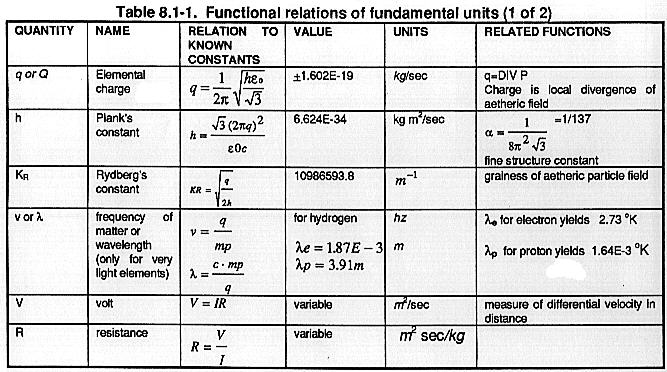
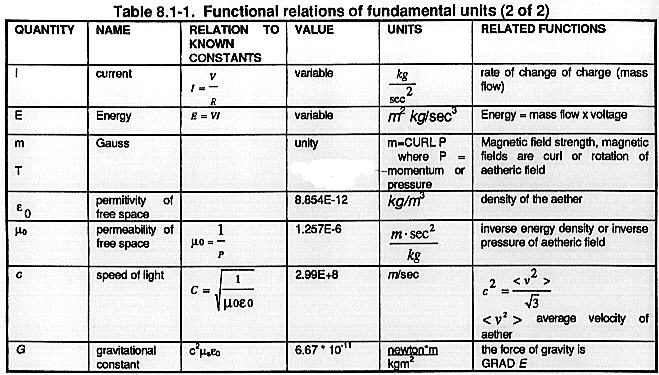
8.2.1 Physics of the Torroidal Electron
When John Keely (circa 1896) first proposed the torroid structure of the nucleus, physics was just startng to get a handle on electrostatics and had only a glimmer of nuclear structure. The electron was discovered in the 19th century by J.J.Thompson in his famous water drop experiment. Since then, various models of the electron have been proposed, but up until the last 10 years none have come up with a physical model which agrees with experimental observation. The current quantum models are mathematical models, which are forced to agree with experimental evidence, but do not explain the electron's physical structure. In the previous section, I used the torroid model to show that it agreed with the charge structure. In this section, I will borrow from Bergman's excellent analysis of the torroidal structure to derive the physical parameters of the electron.
Again, the electron is assumed to be a ring with uniform current and surface charge density. The electron ring is a stable torroidal vortex made of aether rotating at the speed of light. A pictorial of the ring and its dimensions and forces is shown in figure 8.2.1.1-1 and the aether flow (i.e., the magnetic field) is shown in figure 8.2.1.1-2.
The ring has charge e (i.e., the electron charge value) and is distributed uniformly over the surface with charge density of  and is moving with velocity c, the speed of light. Since the ring has no mass but is a current of electrostatic force, the ring can move at light speed without violation of mass/velocity principles. In fact, since the ring is electromagnetic, em forces move at c anyway. The area, a, of the ring is 4
and is moving with velocity c, the speed of light. Since the ring has no mass but is a current of electrostatic force, the ring can move at light speed without violation of mass/velocity principles. In fact, since the ring is electromagnetic, em forces move at c anyway. The area, a, of the ring is 4 2Rr. Thus,
2Rr. Thus,
e =4
2Rr (11)
The energy Ee of the ring is from classical electrostatics13.
Ee = e2/2C (12)
Where C is the capacitance of the ring, the inductive or magnetostatic energy Em is also derived from classical electrostatics.
Em = Li2/2 (13)
L is the self inductance with current i of the ring. The current is also from classical electrostatics and is:
i = ec/2R (14)
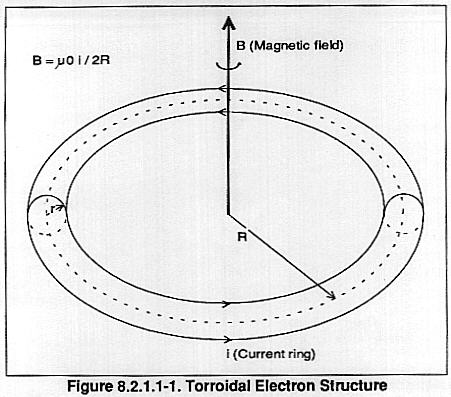
It is thus seen that the electron, as a torroid ring, has both magnetic and electric fields as well as a magnetic moment caused by the ring spin. The magnetic field is shown in figure 8.2.1.1-2 and the electric field radiates from the ring in all directions. This sets up a push-pull relationship to the surrounding space. The electric field will attract or repel e-fields of like polarity and the magnetic field will do likewise for b-fields.
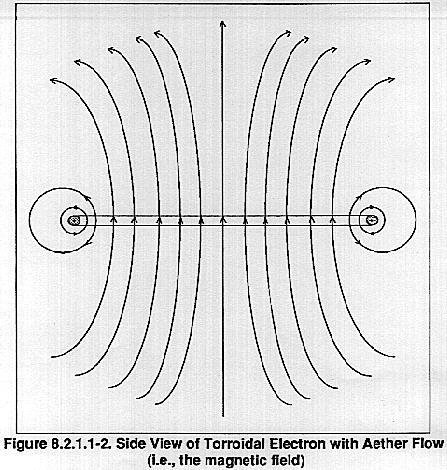
For a very thin ring where r << R the voltage V is computed as follows:
V = 1/(40) (e/(x2 + R2)1/2) (15)
capacitance Ce = q/V (from Sears13: "Electrostatics") but q=e so
Ce = e/V (16)
Combining 15 and 16:
Ce = 40/(x2 + R2)1/2 (17)
The inductance of the ring Le is:
Le = N/i (18)
where N is number of turns, x is the flux and i is the current. N = 1, and  is:
is:
= B x A (19)
where B is the magnetic field and A is the area.
B =0i/2R (20)
Thus:
=
0i
R/2 (21)
If we assume that the energy of the capacitor Ec is equal to the Energy of the inductor EL for balanced energies in the torroid then:
Ec = e2/2Ce (22) EL = Lei2/2 (23)
From (22), (23), and (17) it is easy to show that x = 3R so combining the above:
Le =0
R/2 (24)
The frequency fe of the electron is from the familiar resonance of an LC network:
fe = 2/(LeCe) (25)
Combining (17), (22), and (23) yields:
fe = c/R (26)
From Menzel14 the Compton wavelength fc is:
fc = mc2/h (27)
where c is speed of light and h is Plank's constant. Combining (26) and (27),
R = h/mc (28)
This is the large radius, R, of the electron.
The anomalous magnetic moment can also be computed from this model of the torroidal electron. The ring current i is i = e /2
/2 where
where  is the angular velocity which is c so
is the angular velocity which is c so
i = ec/2R (29)
Magnetic ue is:
ue = Ai (30)
where A is the area of the current torroid. Combining (28), (29), and (30) yields:
ue = he/4m = uB (31)
where uB is the Bohr magneton. Computation of this yields:
ue = 0.92731 which is good to 3 decimal places.
The anomalous electron moment correction14 is:
(1 +/2
- 2.973
2/
2) = ue/u0 (32)
where  is the fine structure constant and
is the fine structure constant and  = 7.29729 x 10-3. When this correction is omputed:
= 7.29729 x 10-3. When this correction is omputed:
ue = 0.928381
which is good to 6 places for the Bohr magneton. More accurracy can be achieved by using a better approximation for the inductance Le and the torroidal shape which is done in Bergman's analysis.
The main point to be made from all this is that the torroid electron model yields good results which are not achievable with classical or quantum mechanics. The other important point is this entire analysis obviates the need for Einstein's theories of relativity since we can derive all the atomic parameters without Einstein's nonsensical assumptions. Lets hope the orthodox community gets whth the program and wakes up.
A summary of the torroid model equations and values are shown in table 8.2.1.1-1. This table also shows the values for the positron, proton, and anti-proton. The proton is related in size by the proton mass to the electron mass ratio of 1836.15. The proton is 1836.15 times more massive than the electron so its magnetic moment, radius, rotation, and current are similarly affected. Appendix B summarizes part of the nuclides of the atomic structure as based on the torroidal particle theory.It is seen that this corresponds perfectly with known electron- and proton-measured values.
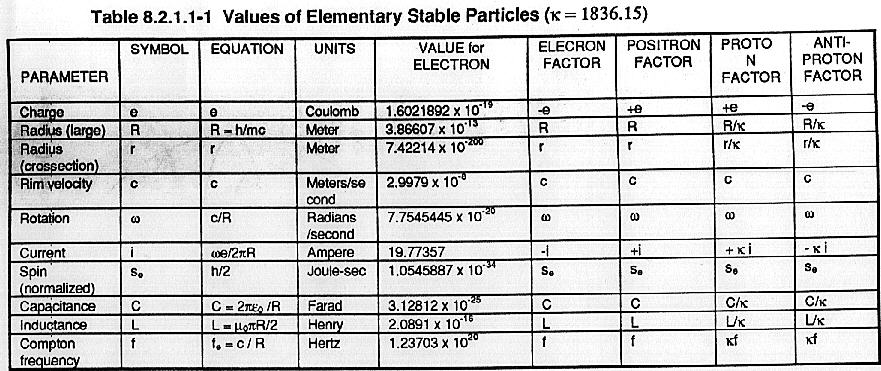
1."Space is the Absolute Reality", Dr. Parmahansa Tewari, International
Conference on Space-Time Absoluteness, Genoa, Italy, July 1982.
2.Beyond Matter,Dr.Paramahansa Tewari, Printwell Publications, 1984.
3."Detection of Stationary and Dynamic Space Substratum", Dr. Paramahansa
Tewari,Raum un Seit, Vol 2, No.1, 1990.
4."Interaction of Electron and Magnetic Field is Space Power Generation
Phenomenon", Dr. Paramahansa Tewari, Magnets In Your Future, Vol 2., No 12, December 1987.
5."Detection of Stationary and Dynamic Space Substratum", Dr.Paramahansa
Tewari,Raum un Zeit,Vol 2, no.1, 1990.
6."A Definition of Electric Charge",Paul Stowe,243 Bentley Court,American
Canyon,California,94589,May 2,1993.
7."The Cause of Gravity", Paul Stowe and Barry Mingst, 243 Bentley Court,
American Canyon, California, 94589, April 28, 1991.
8.Haisch, Rueda, and Puthoff, Physical Review, 1994,pages 678-694.
9."New Spinning Charged Ring Model of the Electron", David L. Bergman,
Twin-Cities Creation Conference, July 29-August 1, 1992.
10."Spinning Charged Ring Model of Elementary Particles", David L. Bergman,
Galilean Electrodynamics, March/April 1991.
11."APhysical Model for Atoms and Nuclei", Joseph Lucas, Galilean
Electrodynamics,January/February 1996.
12."Physical Models for Elementary Particles, Atoms and Nuclei", David L.
Bergman and Charles Wm. Lucas, Jr., IV International Conference: Problems of
Space, Time & Motion, Saint Petersbburg Russia, September 23-29, 1996.
13.Electricity and Magnetism, Francis Weston Sears, Addison-Wesley Publishing
Company,Reading Mass., 1946.
14.Fundamental Formulas of Physics, Donald H. Menzel, Dover Publication, Inc., 1960.
Link:The Neutral Center and the Aether Spectrum (200701051916)